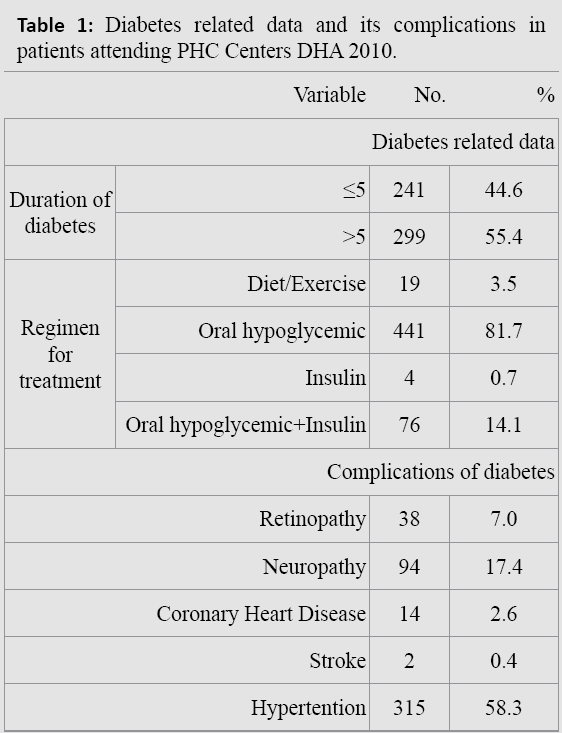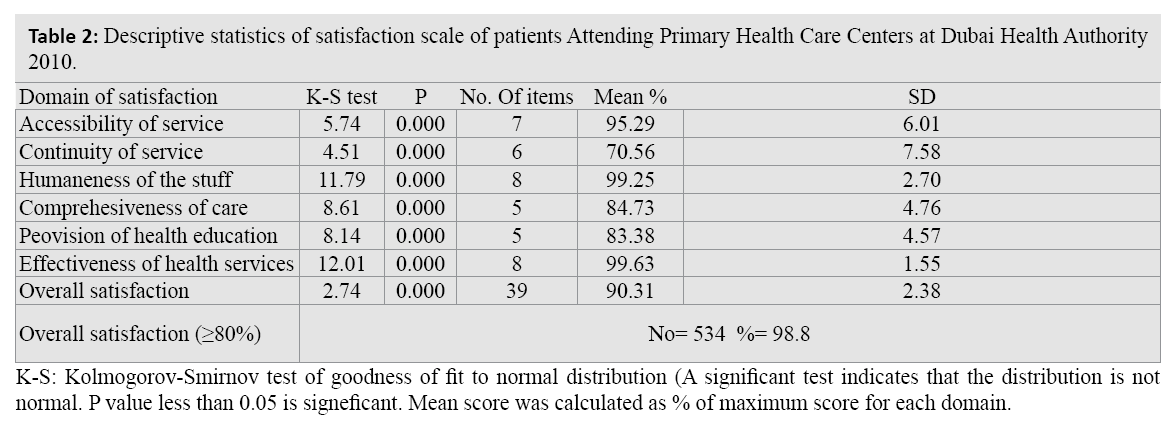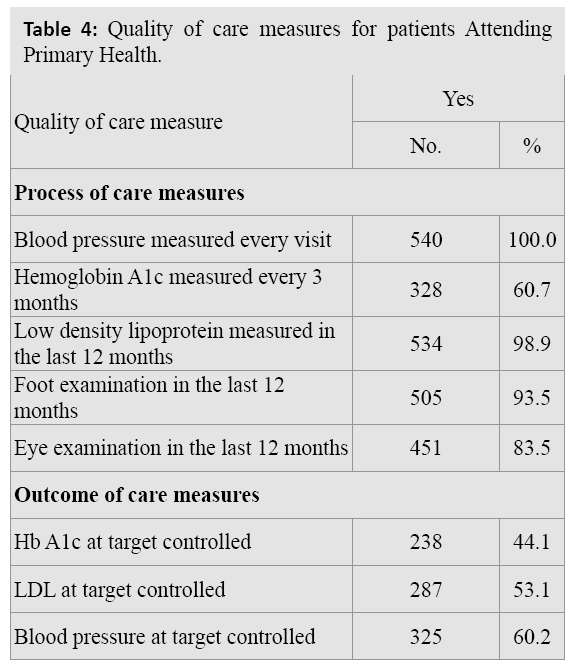Research Article - (2015) Volume 23, Issue 3
Health Centers Department, Primary Health Care Services Sector, Dubai Health Authority, Dubai, UAE
Hussein H*
School and Educational Institutions Health Unit, Health Affairs Department, Primary Health Care Services Sector, Dubai Health Authority, Dubai, UAE
Al Faisal W
School and Educational Institutions Health Unit, Health Affairs Department, Primary Health Care Services Sector, Dubai Health Authority, Dubai, UAE
Wasfy A
Research and Statistics Department, MoH, UAE
Background: Patient satisfaction has been increasingly used as one indicator of the quality of health care. Measures of patient satisfaction are used to compare health care programs, to evaluate quality of care, and to identify which aspects of a service need improvement.
Objectives: To study the characteristics of care provided for patients with diabetes mellitus type 2 at Primary Health Care centers.
Methodology: A cross sectional study among adult patients with diabetes attending centers in Dubai Health Authority. Data were collected using a standardized questionnaire Random cluster sample technique was used with proper allocation of 540 patients with diabetes from Primary Health Care centers/ Dubai Health Authority.
Results: The study showed very high overall patient satisfaction 98.8% while the mean overall satisfaction score was 90.3%. As regarding the different aspects of satisfaction the study shows that the effectiveness of health services and humaneness of stuff got the highest score 99.6% and 99.2 % respectively followed by accessibility of services was 95.2%, comprehensiveness of care 84.7%, provision of health education 83.3% and the lowest score was continuity of care 70.2%.
Conclusions: There is reasonable adherence to the guideline. The process of care showed better adherence than the outcome of care as the process were more related to the system. Filling the gap shown by this study in the diabetic care system at Primary Health Care/ Dubai health authority needs proper addressing to the weakness in the domain of continuity of care by increasing the number of staff to adopt the increased number of patients. The follow up of the patient is recommended to be with the same doctor every visit. If there is a need to be seen by another doctor, the output should be then reported to the treating doctor.
Diabetes mellitus, Quality of care, Patient satisfaction, Primary health care, Dubai
The quality of care for provided for patients with diabetes has become under increased scrutiny and it has received much attention, especially with the continuous increase in the prevalence of diabetes all over the world and as the health care should be safe, effective, efficient and acceptable to the patients. [1,2] Quality in health care is a multidimensional concept that has been variously defined. According to the Institute of Medicine (IOM), quality of care is defined as the degree to which health services for individuals and populations increase the likelihood of desired outcomes and are consistence with current professional knowledge. [3,4] Recently components of quality were identified as a combination of access (whether individuals can access the health care services that they need) and effectiveness (the extent to which care delivers its intended outcome or results). [5] Patients’ satisfaction with their health care is an important measure of health care quality. Patient satisfaction is considered as one of the desired outcomes of care, an element of health status, a measure of quality of care and as indispensable to assessments of quality as to the design and management of health care system. Also, it has been proposed that the effectiveness of the health care system is determined to some degree by the patient satisfaction with the services provided Furthermore, satisfied patients are more likely than dissatisfied one to develop a deeper and longer lasting relationship with their medical care provider leading to improve compliance, continuity of care and ultimately better health outcomes. [6,7] Diabetes mellitus is a highly prevalent chronic non-communicable disease in the United Arab Emirates with a prevalence of approximately 20%.[8] Health care services are provided to the most patients in clinics of primary health care setting thus it's important that these health care services be of quality to guarantee for better health outcomes. Satisfaction is an important factor in predicting the quality of health care services provided to patients. Patient satisfaction in general was studied, but satisfaction of patients is not well known in PHC centers of Dubai. If patient satisfaction is assessed, and its predictors are identified, one aspect of the existing situation of care and the points needed for improvement in this important aspect will be then detected and implications as appropriate health policies may be suggested to improve the satisfaction and subsequently the quality of care.
To study the characteristics of care provided for patients with diabetes mellitus type 2 at PHC centers.
Descriptive cross sectional study was conducted at the primary health care centers (PHC) Dubai Health Authority (DHA). The Study was conducted from July 2010 to January 2011.All adult patients with type 2 diabetes mellitus who are attending the selected PHC centers are enrolled in the study. The total number of diabetic patients following in the primary health care setting is 5400. The sample size was calculated by using computer program EPI-Info version “6.04”. Minimum sample size was 538 and our sample size was 540 patients. Random cluster sampling technique was used. First PHC centers are divided according to the geographic distribution into two regions; Three centers were selected from each region randomly; total six centers were included in the study. Proportional allocation of the patients from the chosen centers was carried All patients who attended the chosen PHC center were included until the completion of the study. Structured interview questionnaire was used for data collection; It was implemented by one researcher. The Questionnaire was used in North American and European survey by other authors including Donabedian.[9] It was translated into Arabic. The questionnaire consists of 39 questions in the following domain: accessibility (7 items), continuity (6 items), humanness of the staff (8 items), comprehensiveness (5 items), provision of health education (5 items), effectiveness of health services (8 items). data was collected through face to face interview.
Table 1 shows that the duration of diabetes was more than 5 years in 55.4% of the cases as compared to 44.6% having diabetes for 1-5 years, more than three quarters of the cases used oral hypoglycemic drugs (81.7%), 3.5 % used only diet and exercise, only 0.7% used insulin and the rest (14.1%) used combined insulin and oral hypoglycemic drug. As regards the diabetes complications, it was recorded among the cases as follows: Retinopathy in 7%, Neuropathy in 17.4%, Nephropathy in 2.6%, Coronary Heart disease in 7.6%, Stroke in 0.4% and hypertension in the vast majority (58.3%)

Figure 1 represent the weight distribution of the patient according to BMI classifications, it demonstrate that more than half of the patient were normal weight follow by overweight and lastly obese 59%, 30% and 11% respectively
Tables 2 and figure 2 show the patient satisfaction scale by domain and by item, comparing the domains together using the percentage satisfaction score revealed that the score was 90% or more in the effectiveness of service followed by humaneness of the staff, then the accessibility of the service. It was more than 80% in case of comprehensiveness of care and provision of health education, and it was the least 70.56% in the continuity of care, the overall satisfaction was 90.31%.

Table 3 and figure 3 shows the relationship between nationality and the domains of satisfaction, it is to be noted that there was a significant difference between national and non-national as regards the following domains: continuity of care (Z = 2.17, P = 0.030) and effectiveness of services (Z = 2.79, P = 0.005) it was founded that locals were less satisfied than non-local.

Table 4 show quality of care measures provided to patients. As regards the process of care, the blood pressure was measured in every visit in all cases, the LDL was measured in the last 12 months in 98.9%, 93.5% had foot examination in the last 12 months, 83.5% had eye examination in the last 12 months and only 60.7% had their Hba1c measured every 3 months. For the outcome of care indicators, it can be noted that 60.2% had their blood pressure at target controlled as compared to 53.1% for LDL and only 44.1% for HbA1c.

The primary health care setting is essential in delivering health care services. It is well known that identification of patient requests, needs and judgment on health care received is the starting point of patients centered approach therefore patient satisfaction is considered as important measure to evaluate the quality of health services and can predict both compliance and utilization that associated with the continuity of care. [10]
Our study provided information regarding the quality of care among adult patients with diabetes mellitus who were attending the primary health care centers in Dubai Health Authority. This was done through assessing patient satisfaction regarding the provided services as well as auditing the files of patients to check if the process and outcome of delivered care is complying with the adopted (ADA) standard of care or not. The total sample size was 540 participants. Our results showed a high overall satisfaction 98.8%, it was near to other studies 99,6 % reported by AL Eisa et al., in Kuwait (2005), 99% reported by Allan in Australia., (2009) and 98% by Gad Allah et al., in Egypt (2003) . Lower overall patients satisfaction was reported by other studies, 64.2% by AL Faris et al., in Saudi Arabia (1996) and 75.2 % by Al Emadi et al., in Qatar (2009). [11-15] The present study showed that, the mean overall satisfaction percent score was 90.3% + (2.38). This was in agreement with other studies by AL Eisa et al., (2005) (88.6%) and by Al Azmi et al., (2006) (85.6%). [11,16] Considering single domain of satisfaction, the scores were very high. The effectiveness of service (99.63+1.55) followed by humaneness of the staff (99.25+2.7), similarly researchers in Saudi Arabia found that humanness and effectiveness domain of satisfaction got highest score. Mansour et al., (1993), while Margolis et al., (2003) in UAE found humanness domain got the highest score in the domain of satisfaction. Accessibility is one of the principles of health for all, as stated in the Alma Ata declaration on primary health care in 1978. [17-19]
It has been reported that accessibility is the strongest predictor of overall satisfaction with quality of health care.[20] The current study revealed a high satisfaction score for the accessibility of the services (95.29+6.01). While in Qatar a study done by Al Emadi et al., (2009) reported that accessibility of the services got the highest score on domain of satisfaction using the same questionnaire. [15] The satisfaction scores for comprehensiveness of care and provision of health education in our study were 84.73+4.7, and 83.38+4.5 respectively. The least score was recorded for continuity of the care (70.56+7.58) because of some problems were encountered by patients such as difficulties in follow up with same physician each time, difficulties in referring system as well as difficulties if the patient missed the appointment as usually there is no call back from the clinic. This result was found to be in accordance with AL-Sakkak et al., (2008) and Mansour et al., (1993) who reported the lowest score for continuity of the care.[21,22]
There is reasonable adherence to the guideline, the process of care showed better adherence than the outcome of care as the process were more related to the system where the health care delivered while the outcome of care is multi-factorial product. Filling the gap shown by this study in the diabetic care system at PHC/ Dubai health authority needs proper addressing to the weakness in the domain of continuity of care by Increase the number of staff to adopt the increased number of patients. The follow up of the patient is recommended to be with the same doctor every visit. If there is a need to be seen by another doctor, the output should be then reported to the treating doctor.